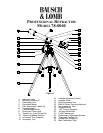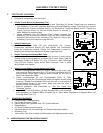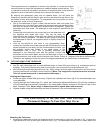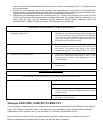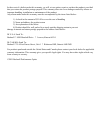
polar axis. Rotate the telescope about the polar axis so that the Counterweight Shaft (7) is parallel to the
ground (horizontal).
• Loosen the Counterweight Lock Screw (located on the counterweight), and slide the Counterweight (6)
along the shaft until the telescope remains stationary without drifting rotationally about the polar axis.
Tighten the Counterweight Lock Screw, locking the Counterweight into position.
• Now balance the telescope about the Declination Axis (3) . Loosen the declination lock screw and the
Cradle Lock Screws so that the telescope can slide freely inside the Cradles. Slide the telescope up or
down inside the rings until the telescope remains stationary without drifting rotationally about the
Declination Axis. Tighten Cradle Lock Screws. The telescope is now balanced.
ANSWERS TO COMMONLY ASKED QUESTIONS
1. The image I see in the telescope is upside down and
reversed from right to left ?
• An upside-down and reversed image is a common
characteristic of all refractor telescopes. Since telescopes are
used for astronomical viewing orientation is not important.
An erecting lens can be purchased separately that will allow
you to see a “natural” image. The image in the finderscope
will also be upside down and reversed.
2. How do I determine the power my telescope ? • The power of your telescope can be determine by dividing
the focal length of the objective lens by the focal length of
the eyepiece. The eyepiece focal length is the number
printed on the eyepiece. (For example: 1000 ÷ 25 = 40X)
3. What can I see with my telescope ? • Telescopes with power ranging from 25X to 50X can be
used to view Star Clusters and Nebulae. 90X to 120X
telescope can view galaxies. Most planets can be seen at
150X and higher.
4. What do the numbers on the eyepiece mean ? • The numbers on the eyepiece represents the “focal Length”
of the eyepiece.
TROUBLESHOOTING GUIDE
If after you have set-up your new telescope you are unable to see an objects, use this Quick Reference
guide to help you to understand the cause of the problem and quickly determine a remedy
1. I’ve completed the set-up yet I cannot see anything • Check to see if objective lens cover has been removed.
• Try to view an object that is 200 or more yards away.
• If there is more than one eyepiece included with the
telescope, use the lowest power (highest number) eyepiece
to begin viewing.
• Use the focusing mechanism (16) to bring the object you
are trying to view into focus
Telescope LIFETIME LIMITED WARRANTY
Your telescope is warranted to be free of defects in materials and workmanship for the lifetime of the original
owner. The Lifetime Limited Warranty is an expression of our confidence in the materials and mechanical
workmanship of our products and is your assurance of a lifetime of dependable service.
If your telescope contains electrical components the electronic components are warranted to be free of
defects in materials and workmanship for one year after the date of purchase.



